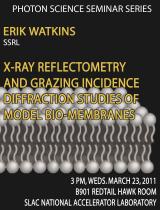Speaker: Erik Watkins, U.C. Davis
Erik Watkins received his BS studying physics at Hampshire College, a school without grades or majors. His first scientific position was as an assistant instrument scientist performing reflectometry research on soft matter in the neutron scattering center at Los Alamos National Laboratory. Working in Tonya Kuhl’s research group, he obtained a PhD in biophysics from the University of California at Davis using scattering techniques to investigate model membranes. Recently, he has accepted a position at Institut Laue Langevin, a neutron scattering facility in Grenoble, France.
Program Description
Biological membranes, composed of a wide variety of lipid and protein molecules, are self-organized structures that define boundaries and compartmentalize space in living matter. Due to the complexity of true biological systems, fundamental physical studies often rely on simpler model systems. Here, X-ray reflectometry (XR) and grazing incidence x-ray diffraction (GIXD) were employed to investigate model bio-membranes. Using XR, density profiles of supported membranes can be obtained as a function of depth with near atomic resolution. If the system diffracts, GIXD provides a sensitive probe of the local structure and packing of lipid molecules within the membrane. These techniques were developed and implemented to investigate the structure of single lipid bilayers on solid supports, bilayers on polymeric cushions, and protein binding interactions. For example, GID was used to establish that dipalmitoyl-phosphatidylcholine (DPPC) lipids exhibit an orientational texture of their tilt directors and are always coupled across a single bilayer. A similar phenomenon is also observed when proteins bind to membrane receptors. Cholera toxin binding perturbed packing within model membranes, resulting in the emergence of a textured lipid phase. It is further hypothesized that textured lipid micro-domains have the potential to play a role in biological signaling and may be involved in the initiation of clathrin independent endocytotic pathways.





